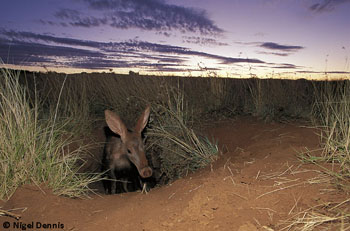A baby aardvark was born in Antwerpen zoo in Belgium on the 6th of January, called ‘Nuru’, which means ‘light’ in Swahili. It is only the tenth baby aardvark born in the zoo in more than 50 years.
The Aardvark (Orycteropus afer), also known as an antbear, has the highest score for being the most evolutionarily distinctive (ED) using the EDGE scientific method. Species such as the aardvark are much more distinct than others because they represent a larger amount of unique evolution: they have few or no close relatives and have been evolving independently for millions of years. The aardvark is the only living representative of an entire order of animals, the Tubulidentata. Its closest relatives in this order have been extinct since the late Pleistocene age (2 million to 10,000 years ago) and now aardvarks are the only remaining species.
The name aardvark comes from the Afrikaan/Dutch meaning “earth pig”, the likeness particularly evident in the nose and face. With a large, powerful body, they typically weigh 50-70kg, with males being slightly larger than females. Their thick skin offers great protection from insect bites and predators. The aardvark’s ears are capable of moving independently of each other, and they have a long tongue which extends up to 300mm. Using their feet, equipped with strong blunt claws, they can dig three different types of burrow: shallow holes when hunting for food; temporary shelters; and large tunnel systems. The aardvark is regarded as a keystone species as the holes it digs are used by snakes, lizards, hyenas and wild dogs. Aardvarks have poor eyesight but they have acute hearing and a good sense of smell to find ants and termites, which are scooped up with their sticky tongues.

Aardvarks occur in a variety of habitats including grassy plains, woodland and savannah. They prefer sandy soils but they are most likely to be found in areas with lots of ants and termites. This species is rarely seen because of their elusive behaviour, and therefore a population estimate is difficult to assess. In southern Africa the population is believed to be stable aside from natural population cycles in response to changes in the environment.
The aardvark has no major threats, but minor threats include habitat loss due to agricultural conversion and hunting for bush meat. Farmers have been known to cull individuals but there is proof that if aardvarks are removed this causes an increase in termite damage to crops. Hausa tribe ‘magicians’ sometimes make the skin of the aardvark into bracelets, and charms are made from the heart, skin, forehead, and nails of the aardvark, which they then proceed to pound together with the root of a certain tree. Wrapped in a piece of skin and worn on the chest, this is said to give the owner the ability to pass through walls or roofs at night.
Find out more about how EDGE calculates evolutionary distinctiveness or see if you can find EDGE species where you live. Enjoy!